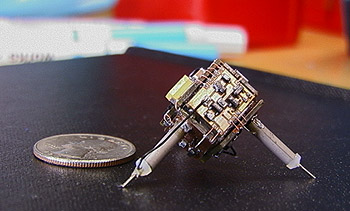 With dog-like or anthropomorphic robots, we've get used to robots of "normal" or "human" size. But amongst the numerous directions robotics research is exploring, small-sized robots are maybe the most promising.
With dog-like or anthropomorphic robots, we've get used to robots of "normal" or "human" size. But amongst the numerous directions robotics research is exploring, small-sized robots are maybe the most promising.
Small robots are light, easy to transport, and can go virtually anywhere. And if they become "very" small, they can even do much more. Like working on atoms - yes, atoms - for instance.
The NanoWalker project has been initiated at MIT at the end of the 90s, at the BioInstrumentation Laboratory. The goal: create "micromachines" that could communicate, move autonomously, and perform task at a very small scale, like moving cells or combining atoms.
The first prototypes have been achieved in year 2000, with the production of robots that can fit on a (small) coin. Equipped with three legs, the machines can move with great precision at a very quick pace (roughly 4.000 steps per second). But they also come with a wireless system allowing communications with a centralized computer, a camera, and will soon get additional tools allowing them to work. Among this tools, a Scanning Tunneling Microscope (STM) is an obvious candidate. It will transform the robots into high precision nano-manipulators, able to "seize" one atom at a time, and pave the way of the creation a nano-factories.

Think about it: based on the present design of the system, "more than 29 trillion operations and more than 120 billion accurate measurements could be performed per week per robot". And of course, such a nanofactory could involve hundreds, or even thousands of robots working 24 hours a day. And the whole factory could fit in your garage...
Photos © MIT
Cyril Fievet, February 8, 2002
Related websites
MIT - NanoWalkers
Previous projects
Entomopters, flying bugs on Mars
All projects
|